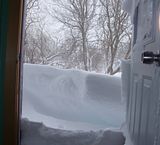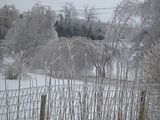Weather with Names
Last night we were storm-stayed again–for the third time this month. Isn’t that a charming term? We’re made to stay inside by the storm.

In actual fact, all the doors are snowed in at least knee high and the path to the car is drifted to my chest. (If, indeed, the car is out there – we can’t see any sign of it anymore.) So storm-stayed we are.
All of our friends in urban, commerce-driven southern Ontario warned us that we would regret the winters here in Nova Scotia, but I have found just the opposite. Yes, there are more storms here. But Maritimers have a more laid-back and rational approach to a winter gale – things shut down. And people are content to stay inside and let the world go by.
In Ontario, I defined weather in simple terms – a thunderstorm, an ice storm, a snowstorm. I knew that most weather came on the prevailing winds from the west. In Nova Scotia, the storm types are named: most notably the Alberta Clipper and the infamous Nor’easter.
Alberta Clippers are spawned in the lee of the Rocky Mountains in Alberta and move swiftly out of the prairies, like the Clipper sailing ships of old, bringing frigid weather to the east. It’s Alberta Clippers that bring most of Hamilton’s snowstorms. Although it might seem otherwise, according to statistics Clippers rarely deposit huge snowfalls. But their cold winds may reach 40 mph (65 km/h) with gusts to 60+ mph (100 km/h), causing severe blowing and drifting of any snow on the ground.
Most of the storms we get here, though, are Nor’easters that, although having winds that blow from the northeast, actually come from south of us. Only along the North American Atlantic coast can a storm truly be called a Nor’easter. By accepted definition, these storms should have gale force or stronger winds initially blowing from the northeast. Those winds seem to suck the heat out right of this old farmhouse!
Nor’easters have become legendary along the Atlantic Coast for their fury and impact, and are the most common severe weather events to worry Nova Scotians. The blizzard we had in February 2005 (dubbed White Juan, after the hurricane just a few months prior) and The Perfect Storm of movie fame were both Nor-easters.
Nor’easters often bring heavy precipitation, falling as rain, snow, or at times, freezing rain. It constantly amazes me how suddenly these storms seem to materialize out of nowhere. The storm earlier this month that brought the ice pictured here was another Nor’easter. 
Followed by five days of below-freezing temperatures, this storm wreaked havoc in the small area of the province to which it was confined. Everything remained as shown for four full days. The ice finally started to melt off trees & wires on the fifth day.
These storm names allow us in the country to communicate in sort of weather shorthand just where a weather system is coming from and how bad we might expect it to be. Rain, blizzard, Clippers, Nor’easter. Some of them cause us all to be storm-stayed and all of them elicit an often-heard Nova Scotian phrase: “I love storm days.” How frequently do you hear that in the city?
Technorati Tags: Nor’easters, storm days, Alberta Clippers, Nova Scotia, storm-stayed, snowstorm, icestorm